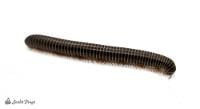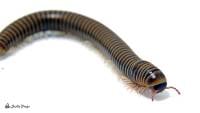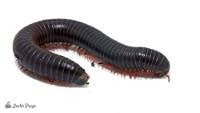Josh's Frogs
American Giant Millipede Care Guide

American Giant Millipede (Narceus americanus)
American Giant millipedes are large terrestrial animals that inhabit forests and agricultural areas of eastern North America. Active in spring through fall, they can be found under rocks, rotting logs, leaf litter, and other decaying plant material.
These millipedes are primarily nocturnal, preferring dark and damp areas where they spend most of their time foraging, eating, and grooming. During the cold, winter months, they hibernate. American giant millipedes can grow twice as large as any other millipede in North America, reaching up to 4 inches in length.
This species of millipede has a life expectancy of about 2 years in captivity, although many millipedes can live longer. Because most millipedes are collected in the field as adults, it's very difficult to determine their potential longevity.
The bodies of all millipedes are divided into repeating segments, with 4 legs per segment, and although the name millipede means “thousand-feet,” the North American millipede only has about 300 to 400 legs on average.
Molting
Most giant millipedes are sold as adults, but if you happen to get an immature millipede, it will molt several times as it grows. As they molt, they grow additional body segments with legs.
Handling
American Giant millipedes do not bite or carry any diseases that affect people. They are generally safe to handle. As a natural defense mechanism, they will curl up in a tight ball when disturbed. If threatened, the millipede may secrete a yellowish brown chemical compound from glands along the sides of its body. This secretion is toxic to predators and may cause a burning sensation on sensitive skin.
It may take some time for your millipede to warm up to you and feel comfortable with being handled. It's best to admire millipedes from their enclosure.
Always wash your hands thoroughly with soap before and after handling millipedes.
Housing & Decor
Millipedes will do well in plastic bins or glass aquariums. They are very communal and can be housed together with few problems. Millipedes don’t require many decorations. They do however need shelter. A slab of cork bark will provide them a place to dig under and hide.
Substrate
Experts say that substrate is the most important aspect of a pet millipede's enclosure.
The foundation of the substrate should be something that holds moisture. The most common substrate for millipedes is 4-5 inches of peat moss.
The general rule of thumb is that substrate should be as deep as your millipede is long. A low amount of calcium supplement powder should be mixed into the substrate, such as Josh's Frogs MicroCal. The most important ingredient in a pet millipede's substrate is a layer of untreated decaying hardwood leaf litter (especially oak). Some suggest that just decayed oak wood mulch and dry oak leaves alone is ideal bedding for millipedes.
Josh's Frogs Milli Mix is the ideal substrate for your pet millipedes, and contains everything your pets need to stay happy and well fed.
Temperature & Lighting
American Giant millipedes do best in room temperature, with the ideal temperature being 75 degrees F. Make sure to monitor temperature with a digital thermometer.
Because millipedes are mostly nocturnal, they do not require any special lighting. In fact, it is best to avoid bright light in your millipede's enclosure as they shy away from it. If you would like to observe your millipede at night, it’s best to use a non-heat producing black light fixture.
Humidity
Millipedes thrive in high humidity. It’s recommended to have humidity levels between 70-80%. To achieve this, mist the enclosure once in the morning and once at night.
Avoid allowing your bedding to become too wet. The surface of the substrate should always stay moist. Millipedes can dry out overnight if they were to become too dry. Monitor humidity with a digital hygrometer.
In addition to humidity, it is also important to have adequate ventilation. The correct ventilation may vary by species, but open screen covers for enclosures are usually not recommended as it can cause the enclosure to dry out too quickly. It’s best to use an air-tight container with small holes punctured through the sides. Millipedes do not need much ventilation, but inadequate ventilation can promote the growth of mold.
Water
Many millipede owners provide a water dish in their enclosures as a water source, but that’s not really necessary. Millipedes get moisture through the food they eat as well as their environment by misting the enclosure regularly. We recommend using reverse osmosis, distilled, or spring water. If you're going to use tap water, make sure to use a quality water dechlorinator.
Diet & Nutrition
Millipedes are not picky and will consume almost anything that is offered. Pet millipedes can be given a variety of fruits and vegetables, but their primary diet should be their substrate. Besides substrate, some foods that are readily eaten include cucumbers, apples, pears, melons, carrots, and potatoes.
Although millipedes are natural decomposers, it’s best to feed them fresh food. Be sure these foods are washed thoroughly before being offered to your millipede. Uneaten or rotting food should be thrown away after two days.
Millipedes can also be given crushed eggshells or cuttlebone as a source of calcium
[button-green url="https://www.joshsfrogs.com/animals-for-sale/pet-insects-invertebrates.html" target="_blank" position="center"]Buy Millipedes[/button-green]



